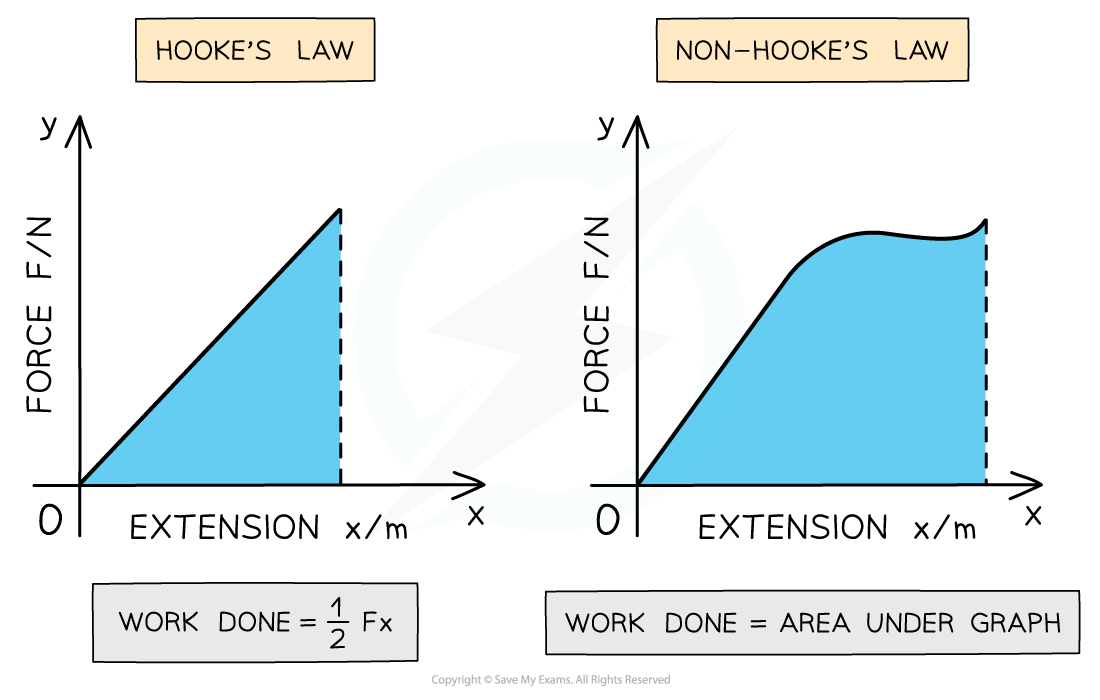Elastic Potential Energy (Cambridge (CIE) AS Physics): Revision Note
Exam code: 9702
Area under a force-extension graph
The work done in stretching a material is equal to the force applied multiplied by the extension created
Therefore, the area under a force-extension graph is equal to the work done to stretch the material
Area under force-extension graphs

Work done is the area under the force - extension graph. This is true for graphs that obey Hooke's law and those which don't.
For a region where a material demonstrates elastic behaviour and obeys Hooke’s law the work done is the area of the right angled triangle under the graph
For a region where a material doesn’t obey Hooke’s law, the total area is the sum of the areas of the separate sections under the graph
Worked Example
The graph shows the behaviour of a sample of a metal when it is stretched until it starts to undergo plastic deformation.

What is the total work done in stretching the sample from zero to an extension of 13.5 mm?
Simplify the calculation by treating the curve XY as a straight line.
Answer:
Step 1: Recall how to determine work done from the graph:
Work done is the area underneath the force-extension graph
Step 2: Calculate the area under the graph up to point X:
To point X, the area under the graph, AX , is a triangle
Calculate AX , remembering to convert length to metres
Step 3: Calculate the area between X and Y:
Assuming the line XY is a straight line, the area under this region of the graph forms a trapezium
Recall the equation for a trapezium of width h and side lengths a and b
Here, h is the change in extension from X to Y, 2.5 mm
a is the load at point X and b is the load at point Y
Step 4: Calculate total area:
The total area, the total work done, is just the sum of these two areas
The answer is given to 3 significant figures, as the data has been given to this number of significant figures
Examiner Tips and Tricks
Make sure to be familiar with the formula for the area of common 2D shapes such as a right angled triangle, trapezium, square and rectangles. If you do forget the equation for a trapezium's area, however, just split the shape up into rectangles and triangles.
Elastic potential energy
Elastic potential energy is defined as the energy stored within a material (e.g. in a spring) when it is stretched or compressed
Elastic potential energy for a material deformed within its limit of proportionality is found from the area under the force-extension graph
So, the work done is also equal to the elastic potential energy stored in the material when it demonstrates elastic behaviour up to the limit of proportionality
Worked Example
A spring is extended with varying forces; the graph below shows the results.

What is the energy stored in the spring when the extension is 40 mm?
Answer:
Step 1: Recall how to determine energy sto
Energy stored in the spring is equal to area under the graph, A
This is a triangle, so can be calculated using
Step 2: Find the area under the graph
At 40 mm, the load is approximately 8.3 N
Converting length into metres gives an area of
This is equal to the energy stored in the spring, which should be given to 2 significant figures
Examiner Tips and Tricks
In your exam, a range of values will be allowed for the load at 40 mm. Any value from 8.1 N to 8.5 N will gain a mark. If you are struggling, draw horizontal lines on the graph to show the positions of 9.0 N and 8.5 N.
Calculating elastic potential energy
Recall that for a material obeying Hooke’s Law, within its limit of proportionality, elastic potential energy and work done can be calculated using the following equation:
Recall the equation for Hooke's law:
Combining these two equations gives an equation for elastic potential energy in terms of spring constant, k:
Where:
k is the spring constant (N m-1)
x is the extension (m)
Examiner Tips and Tricks
The formula for EPE = is only the area under the force-extension graph when it is a straight line i.e. when the material obeys Hooke’s law and is within its elastic limit.

Unlock more, it's free!
Did this page help you?